Asian Textile Studies
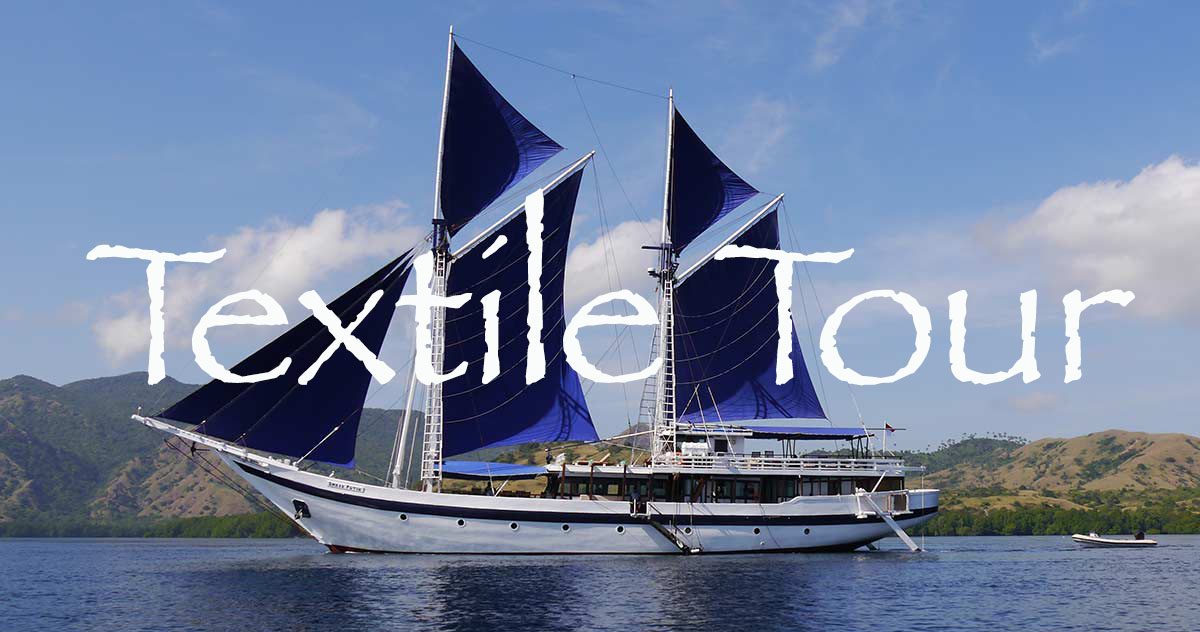
Contents
Cultures and Textiles of the Lesser Sunda Islands
The Cultural Tour Itinerary
The LaMaIn Voyage II
The Public Areas of the Boat
The Eight Ensuite Cabins
Tour Brochure
Pricing
How to Book
Life on Board
Guest Testimonials
External Links
Cultures and Textiles of the Lesser Sunda Islands
The most exciting cultural tour you are ever likely to find – the trip of a lifetime!
We are not tour leaders - we are serious textile scholars who have been studying the weavings of Indonesia for over thirty-five years. During this time we have visited almost every part of the Indonesian archipelago, assembling one of the most extensive private collections of Indonesian textiles on the planet. Indeed this growing website illustrates our deep understanding of both the region and its weaving culture.
We have led this textile tour once every year since 2014 because it is a fabulous voyage and the highlight of our year. Although we take our textiles seriously, this tour is also great fun, with a group of like-minded travellers sharing an amazing adventure. However its not all culture and textiles - we also make time for visiting non-weaving villages, markets, museums, schools, churches and mosques, as well as swimming, snorkelling and relaxing.
Next year's tour will be our eleventh, beginning at Ende on Flores on Monday 4 May 2026 and finishing at Waingapu on Sumba on Monday 19 May. If you would like to meet the artisans who still produce the most beautiful textiles in eastern Indonesia and understand how they are made and used, then come and join us.
We are now taking bookings for our 2026 tour. Please contact us as soon as possible if you would like to join us.

Children dressed in ceremonial costume in a weaving hamlet on Savu Island
The remote ikat-weaving islands of eastern Indonesia have one of the most diverse textile cultures on the planet. Hand-woven cloth plays a pivotal role in the cohesion of all these societies, cementing clan alliances through complex gift exchanges, reinforcing tribal loyalties and underpinning the annual cycle of rituals. As some islanders emphasize: ‘without cloth we cannot marry’.
Sadly the encroachment of the modern world means that the number of communities where women still continue to spin their own cotton, prepare their own natural dyes and weave on traditional back-tension looms is limited. Their numbers are dwindling, and within a generation many could be gone for ever.
One of the last remaining strongholds for these textiles are the stunningly beautiful Lesser Sunda Islands, which stretch out eastwards beyond Bali. We first visited these remote islands in 1991 and have been returning ever since. Many of the villagers and weavers we will spend time with are our friends. Let us share our expertise with you as we explore this remarkable region together.

The only way to travel through the Lesser Sunda Islands
Return to Top
The Cultural Tour Itinerary
Previously we have offered two separate tours: a short land-based tour on Flores and a longer cruise through the Lesser Sunda Islands. Since the majority of our guests booked for both trips, we decided to combine them into a single 15-day, 15-night cultural adventure. Our revised itinerary allows us to offer this incredible trip at a significantly lower price than before. We are delighted once again to be working with the award-winning team at Asia Global Yachting, using a modern Indonesian phinisi, only built in 2022, which has just eight luxury cabins, seven of which will be available for guests.
Our eleventh textile tour begins by visiting some important ikat-producing villages on Flores Island that cannot be easily accessed by sea. Our guests will be met on their arrival at Ende Airport on 4 May 2026 following their morning flight from Denpasar on Bali, which involves a stop-over in the port of Labuan Bajo. We will immediately set off to see some of the highlights of Ende city, including the huge Catholic Cathedral, a local market and the Bung Karno Museum, the former home in exile of Sukarno, the leader of the Indonesian independence movement, who would later become the nations’ first President. It was here that he formulated his mission statement for an independent nation, which would eventually be known as the Pancasila.

The Bung Karno Museum in Ende City
The next morning we will take a short drive up to a weaving hamlet in the district of Ndona, where a small cooperative produce traditional Lio ikats using only natural dyes. It is typical of the many small-scale weaving ventures that we will be encountering over the next two weeks. From here we head into the mountains to spend a few hours in a fascinating hill-side village inhabited by the Lio mountain people. Although textiles are a feature of daily life, weaving is absolutely forbidden by customary law. We will enjoy our packed lunch in the village school, where the local children will entertain us with songs and dances, including the challenging bamboo dance. Afterwards our host and friend, the local clan leader (called a mosa laki) will escort us around the village and tell us about its history and culture.

A small weaving cooperative at Ndona on Flores Island
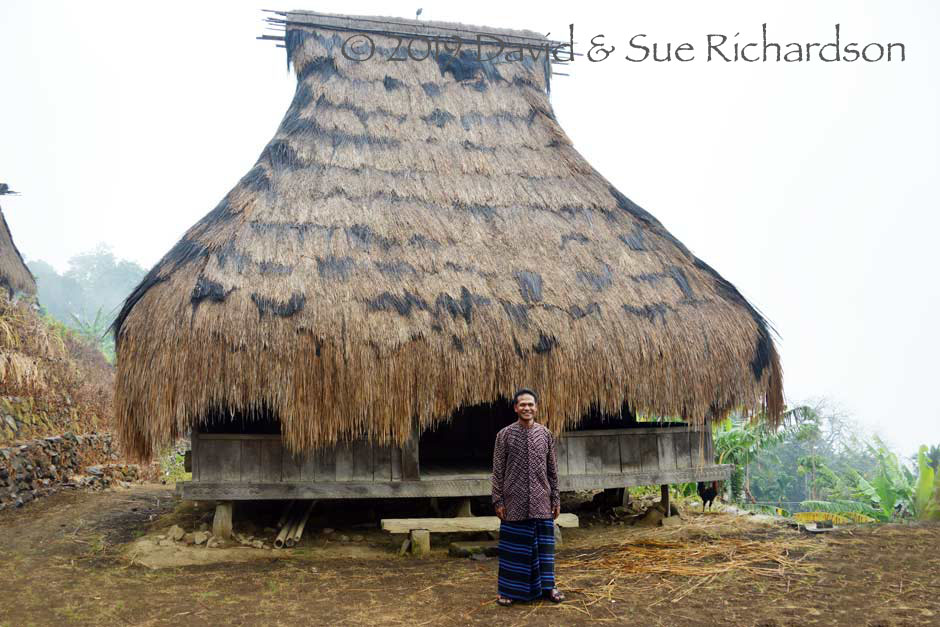
Our friendly host and the chief of the Wolo clan in front of his ancestral home in a small Lio village in the mountains of Flores
Our home for the next two nights will be the modern ensuite bungalows at the Kelimutu Crater Lakes EcoLodge in Kelimutu National Park, set beside a babbling mountain stream and surrounded by rice fields. The climate is cool and fresh, and the EcoLodge gardens are a haven for wildlife.
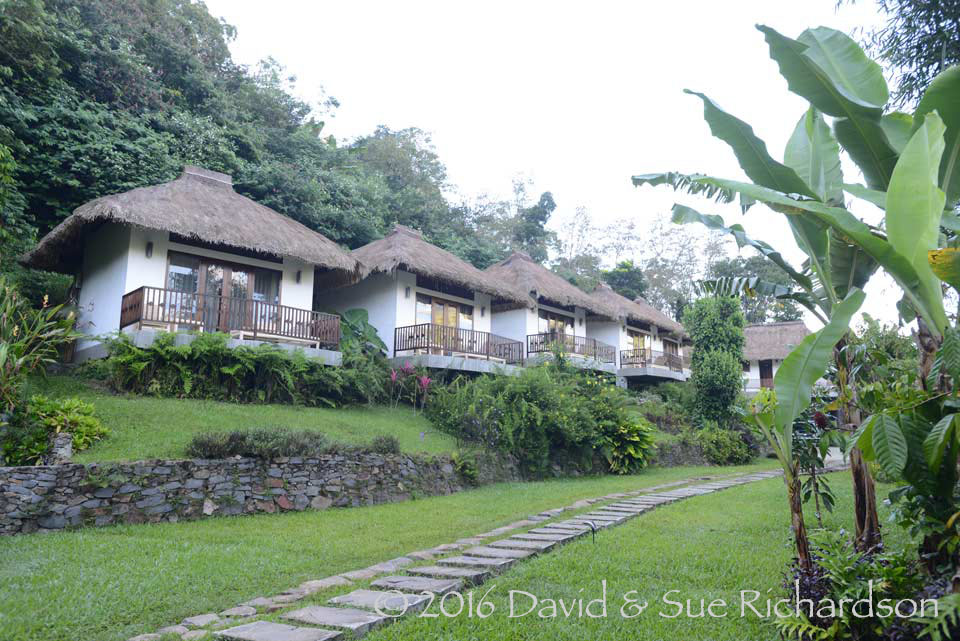
Some of the bungalows at Kelimutu EcoLodge, Moni
The view from one of our bungalows at the EcoLodge
After breakfast the following day we drive towards the coast to visit a remote Lio weaving village that is renowned for its culture and the quality of its ikat textiles. We will be shown all stages of the weaving process, will be invited into clan houses and served local coffee and fresh coconut. We return to the EcoLodge for lunch, after which guests are free to relax in the beautiful surroundings, or perhaps enjoy a walk through the nearby rice fields.
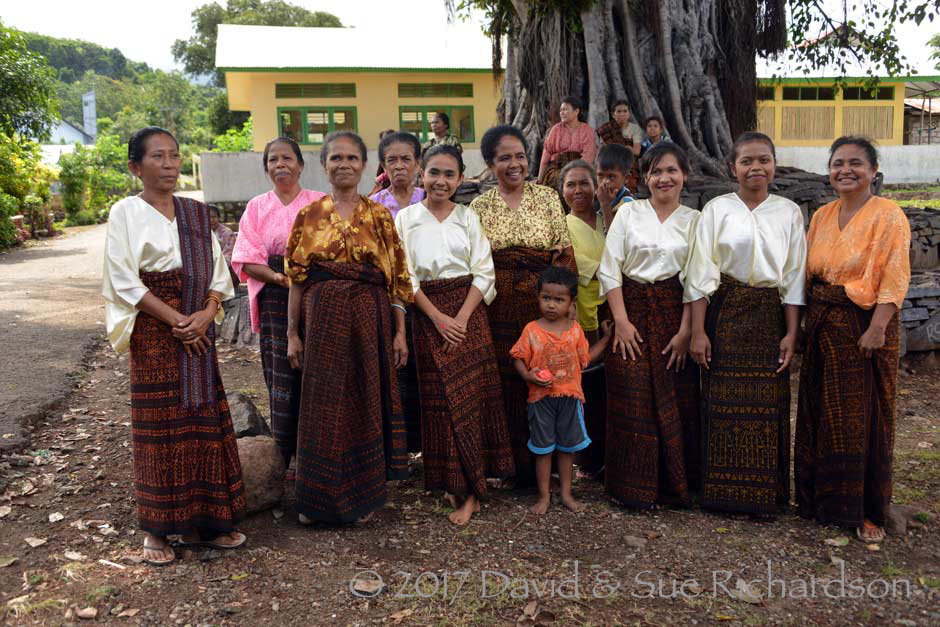
A local cooperative in the most important Lio weaving village in the Ende region
After early morning coffee on the fourth day, we will drive up to the Kelimutu volcano carpark from where we can walk to views over the extraordinary crater lakes within its three calderas. Not only does each lake have a different colour, but the colours vary over time. Back at the EcoLodge we will enjoy a well-earned breakfast before heading off east on the Trans-Flores Highway to the town of Maumere.
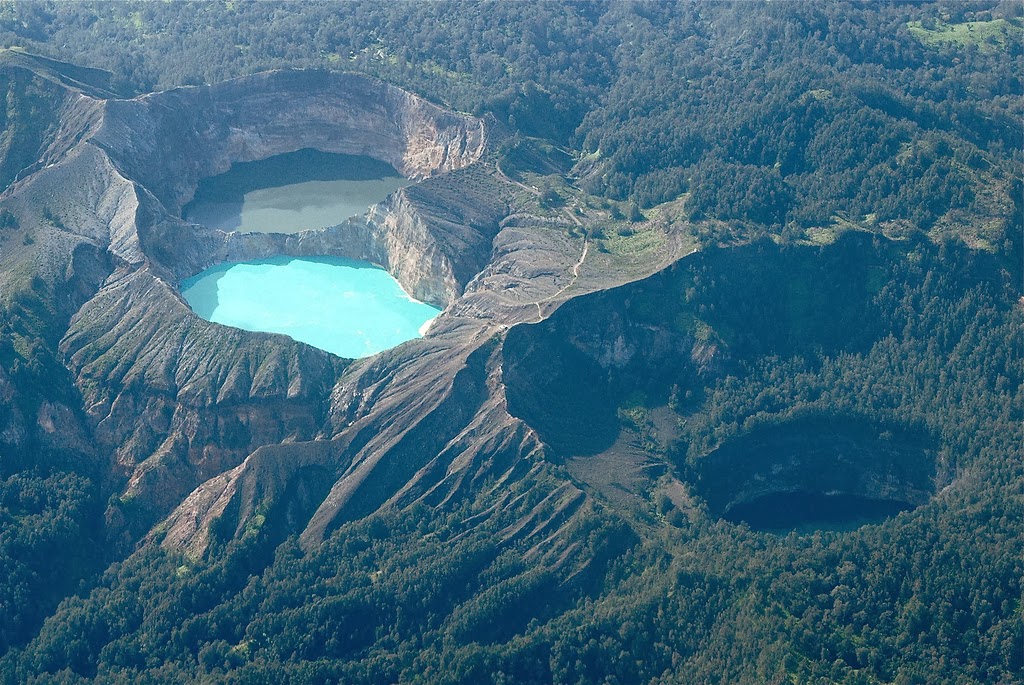
The amazing volcanic crater lakes in Kelimutu National Park tinted with three different colours - the only place on Earth where this colour variation takes place
After arriving at our modern hotel in Maumere, we will enjoy a late lunch followed by a short rest. Later that afternoon we will make an excursion to a busy Muslim fishing village occupied by Bugis and Bajau people, famous for their stilt houses built above the water. In the evening before dinner David and Sue will give an introductory talk about the culture and textiles of the local Sikka people.
After breakfast the following day we will visit an extremely busy local market, where many weavers purchase their threads and dyes. From there we drive up into the highlands to visit a small village where we will be welcomed with music and dancing. After gaining more insights into the local techniques of spinning, binding, dyeing and weaving, we will have the opportunity to purchase some of the finished textiles. We return to the port of Maumere to board our beautiful phinisi in time for lunch. The crew will immediately raise the anchor and we will sail out to a small uninhabited island for beachcombing, swimming and snorkelling.
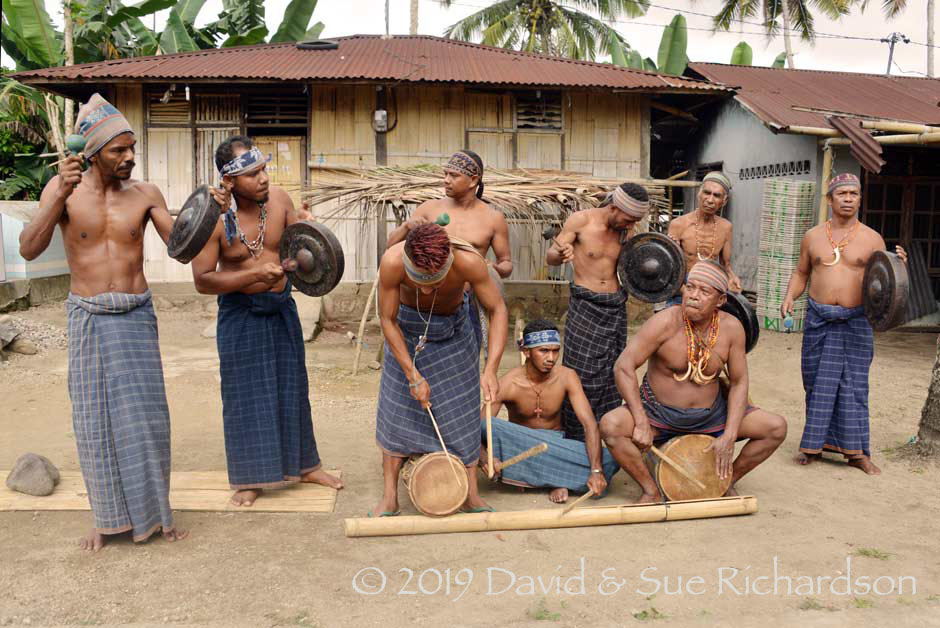
Musicians at a weaving hamlet in the highlands of Sikka
Overnight we will sail east to the far end of Flores Island, named the Cape of Flowers by the early Portuguese sailors, from which the whole island derives its name. After sailing past a towering stratovolcano, we will anchor in a sheltered picturesque bay. We will go ashore to be welcomed by local Lamaholot villagers who will show us in detail how they produce their fantastic earthy-brown ikats decorated with small white seashells. We can then walk around this colourful well-kept village before returning to our phinisi for lunch.
The afternoon is free to relax on board, or enjoy water activities such as kayaking or paddleboarding.

Our mooring off eastern Flores
From our overnight mooring we sail along the south coast of Adonara to visit an important weaving community. They live in a fascinating village built on the flank of an active volcano. The people of Adonara are also Lamaholot, but they are a mixed Muslim/Christian community and their weavings are quite different from those we will have seen so far. After another busy morning we will enjoy lunch on board before sailing to some tiny remote islands for a refreshing dip.

Some of the weavers on Adonara
From our dramatically located overnight mooring it is a short crossing to the north coast of Lembata Island to visit the villages that lie at the foot of the active volcano of Ilé Apé. Here local weavers produce some of the finest ikat textiles in the region. After a formal welcome and demonstration of local weaving techniques there will be a selling exhibition of textiles, giving you the chance to add a fabulous bridewealth cloth to your collection. Later, during lunch, the boat will cruise around the headland to a secluded spot for excellent snorkelling.
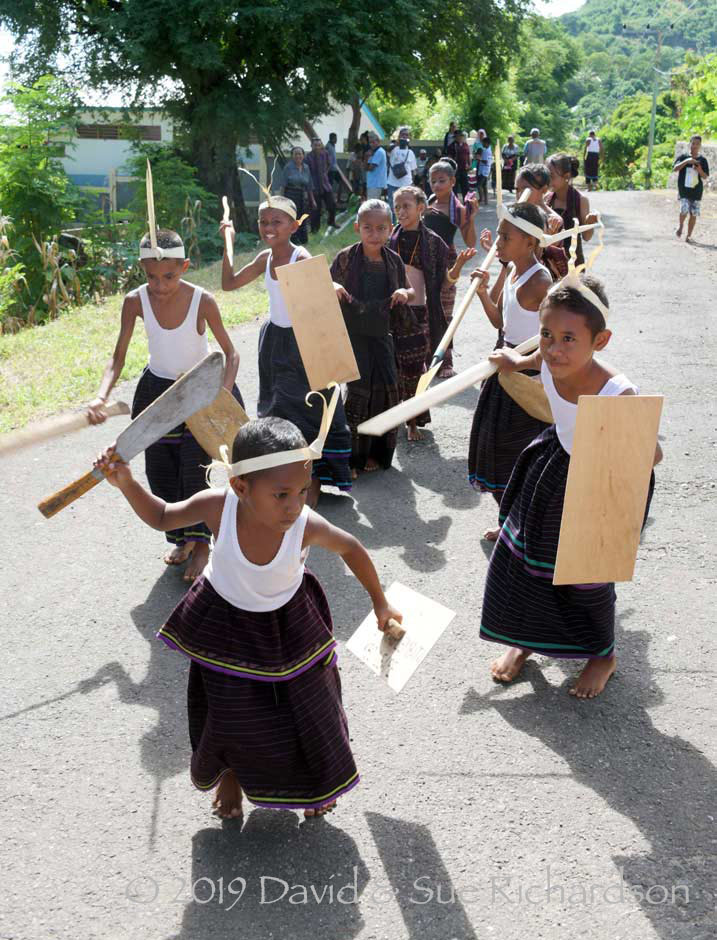
The children of Ilé Apé are ready to give us a very special welcome

Some of the weavers living at the foot of the Ilé Apé volcano on Lembata Island, every one a skilful drop-spinner
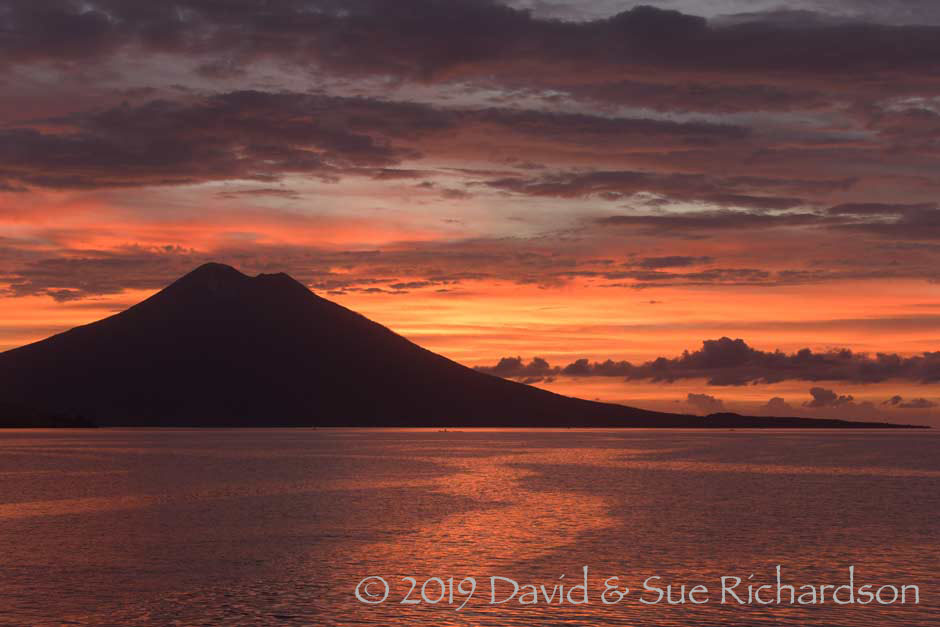
A stunning sunset behind the volcano of Ilé Apé from our evening mooring
The following day we continue our voyage eastwards, spending the morning on the tiny island of Ternate, where they produce over one hundred natural dyes, some from marine sponges and sea hares. We will have the chance to see and buy many of their fabrics and see how the fishermen make superb bamboo fishtraps. Over lunch we sail into Kalabahi harbour on the rarely visited island of Alor, mostly inhabited by Papuan people belonging to the Abui tribe with a very different culture from the people we have seen so far.
We will be invited to join in the hypnotic lego-lego dance before shopping for textiles, baskets and jewellery at a small pop-up market. We will return via the Kalabahi Museum of One Thousand Mokos, where we will see their fine display of textiles and bronze moko drums from across the island.
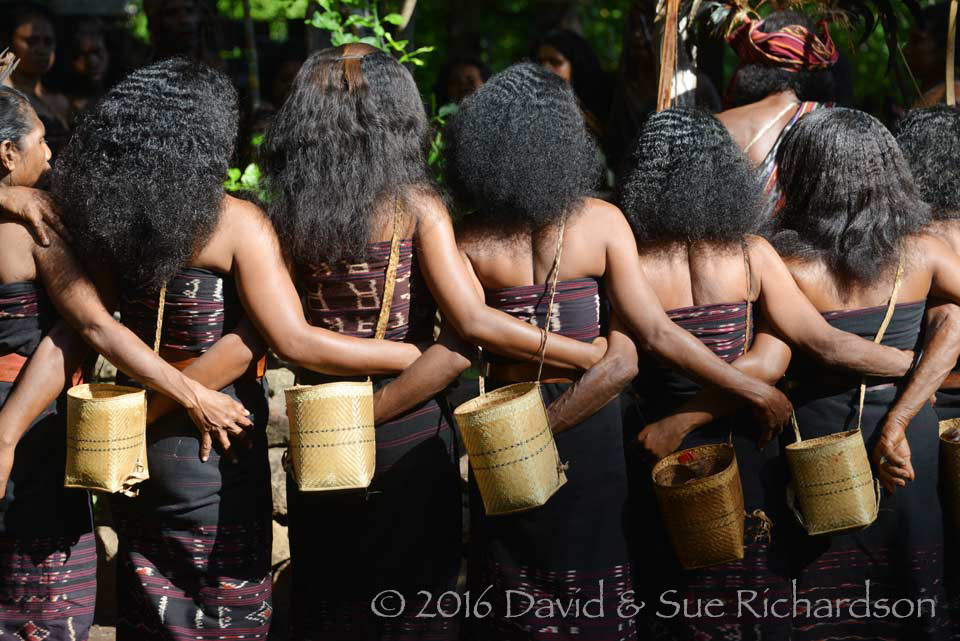
Women from the Abui tribe performing the lego-lego dance on Alor Island
Overnight we sail west to the extraordinary whaling village of Lamalera, on the southern side of Lembata, landing on the beach in front of a row of thirty whaleboat sheds. After a welcome by our friend, the kepala desa, we will be entertained with dance performances and shown demonstrations of local dyeing and weaving. Many textiles and other artefacts will be available to buy. We then go to the upper village to visit the school and the massive Catholic church of Saint Peter and Paul, getting excellent views of the boatsheds as we descend. The village head will then show us some of the whaleboats and explain how their crews manage to harpoon huge passing whales from their tiny locally-made wooden craft.
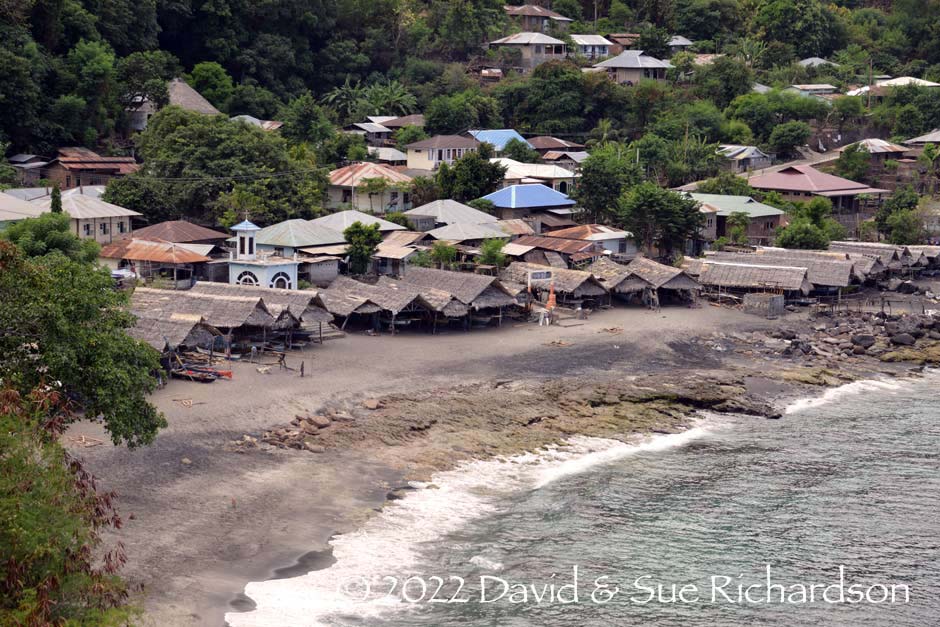
The whaleboat sheds at Lamalera on Lembata Island
Returning to the boat we will sail round to the next bay, where we will be met by locals in a traditional whaling boat, who will proceed to demonstrate the way they still catch whales using harpoons. During lunch we will reposition to an area, where we can once again enjoy water activities.
Next morning, we will go ashore at a small beach in the southwest of Solor, where we will be bussed to a nearby village. The local villagers see very few visitors, so will entertain us with a colourful and enthusiastic welcome, with everyone dressed in their finest clothing. Some of the women will demonstrate how they make their textiles, and a selection will be offered for sale.

Dancers dressed in their finery on Solor
Lunch will be served as we begin our long sail across the Savu Sea to the beautiful non-volcanic low-lying island of Savu far to the south, whose people are renowned for their horsemanship, their dependence on the lontar palm tree and their fine weavings. After our busy schedule, this is an opportunity to wind down and relax.
After breakfast the next day we go ashore at Napae Bay, following in the footsteps of Captain Cook who landed HM Bark Endeavour on the same beach in 1770. We will drive to a tiny hamlet in the hills, where local weavers will warmly welcome us and show us how they still make their beautifully traditional naturally dyed cloths. The men will demonstrate how they climb the tall lontar palms to tap their delicious juice, which of course we will be able to sample. We return via the amazing limestone rock formation of Kelabba Maja. After lunch we will stop at a pristine sandy beach for swimming and relaxation.
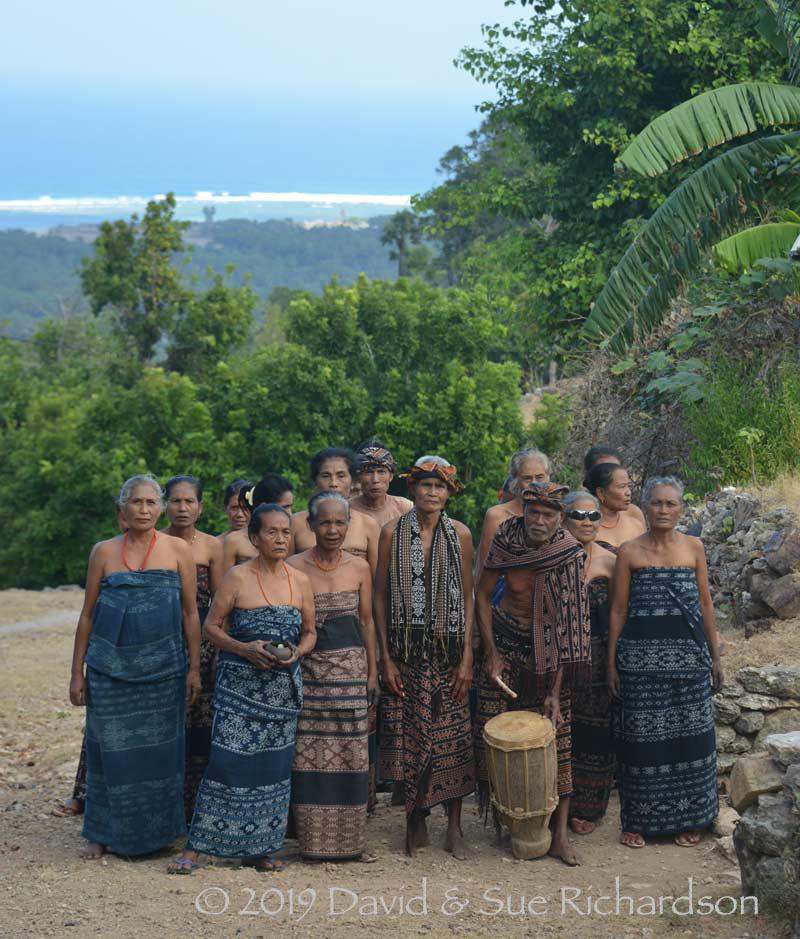
A formal welcome at the most important weaving hamlet on Savu Island
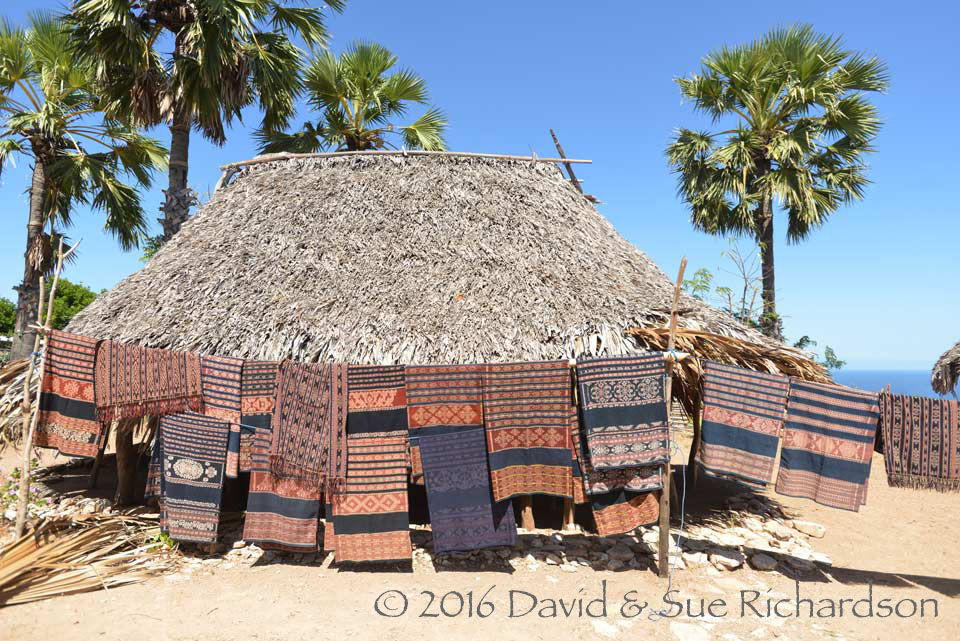
Textiles for sale on Savu Island
Overnight we sail further west across the Savu Sea for the first of three fantastic days on the island of Sumba, the highlight of our tour. After breakfast we will say farewell to our crew as they land us on a sandy beach on the east coast of the island. Our luggage will be taken to Waingapu and then transferred to our modern hotel on the coast overlooking Waingapu Bay.
A local bus will ferry us to two amazing but quite different royal villages, each with megalithic graves surrounded by tall traditional thatched houses. We will meet members of two local royal families and see how they make some of the finest textiles to be found on the island, using the techniques of supplementary warp and warp ikat - sometimes even combining both techniques in one textile. The choice of high-quality textiles for sale is mindblowing. Afterwards we will enjoy a picnic on a nearby beach before driving north to our hotel at Waingapu, the capital of East Sumba.

Weaving a woman's skirt decorated with supplementary warp

Some of the fabulous textiles on offer to our guests on Sumba island
The following morning we will drive to a local weaving studio where we will be given an in-depth demonstration of how the islanders make their amazing pictorial men's blankets, many of which will be for sale. We will then cross the road for a short walk through the interesting village of Prailiu, the royal seat of the Raja of Kambera, before taking lunch in our hotel. In the afternoon we will drive north of Waingapu to explore the region of Kanatang, where local women specialise in indigo dyeing and the weaving technique of alternating complementary warp. They also decorate some of their cloths with cockatoo motifs. Dinner will be taken in a fashionable Waingapu restaurant and bar.
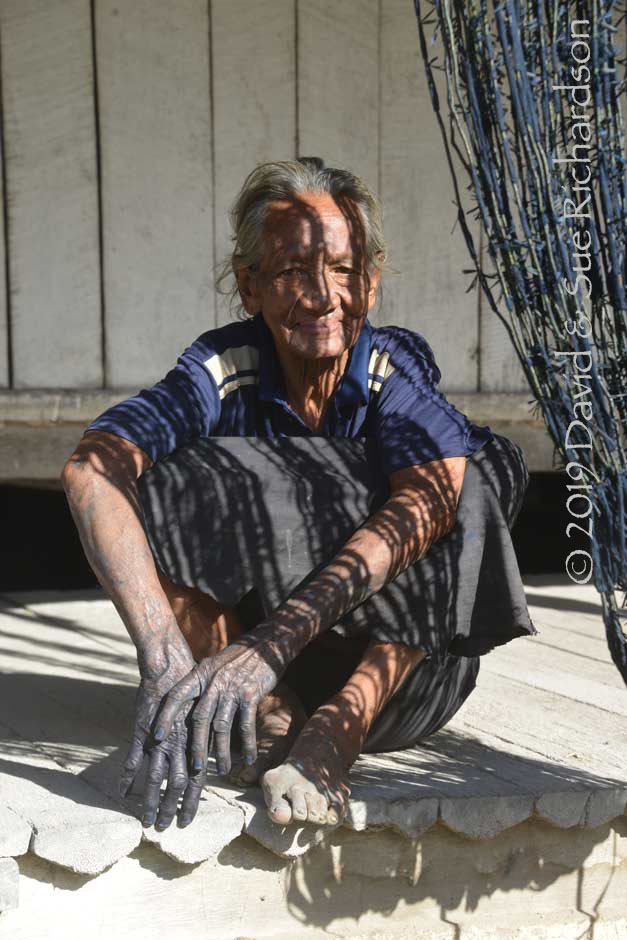
An indigo dyer taking a rest on her veranda on Sumba island
On our last full day on Sumba we will drive through rice fields to a rarely visited weaving village to be greeted by ikat-clad warriors on horseback. Sitting in the shade on the veranda of a traditional house we will be welcomed by the entire village and entertained with traditional dances that are still used to welcome important visitors and were used in the past to welcome the warriors back from their headhunting expeditions. Textiles will be hanging everywhere and we will be offered a huge array of jewellery, statues, boxes, baskets and other crafts.
Lunch will be taken at a small café on the outskirts of Waingapu after which we will all return to our hotel for a rest or final swim in the pool.
On our final evening we will celebrate the end of our tour at a rural restaurant situated in a stunning location overlooking a small river surrounded by grass-covered hills.
The following morning we will be transferred to Waingapu airport for an early morning flight to Denpasar. Alternatively some guests may wish to spend a few more days on Sumba, possibly exploring the western part of the island.

Young dancers performing at an important ikat-producing village in East Sumba
In village after village we will see people dressed in the same ceremonial outfits that they wear for their own private traditional rituals and festivals - textiles that you would never see if you visited these villages alone. We will witness every aspect of ikat production and natural dyeing and have the opportunity to purchase fabulous textiles directly from the women who made them. Before each visit guests will be fully briefed so that they completely understand the culture of each region and the type of textiles and techniques they will encounter, along with the role that cloth plays within their community.
Our journey will take us through a dramatic volcanic and non-volcanic landscape during which there will be time to relax, write-up journals, swim, snorkel, sunbathe, and beachcomb.
Come and join us on a fantastic, adventurous voyage of a lifetime!
Return to Top
The KLM LaMaIn Voyage II
Built in 2022, LaMaIn Voyage II is a traditional Indonesian phinisi made of local ironwood and teak. Some 41.5 metres long and 7.9 metres wide, she is powered by a 500 hp diesel engine that allows her to cruise at between 7 to 10 knots. The boat is staffed by an experienced crew of thirteen, and her eight air-conditioned cabins can accommodate fourteen guests.

The upper deck houses the navigation room, the captain and cruise director’s quarters and two large luxurious cabins (Master and VIP).

The main deck has the outdoor dining area, the bar and lounge, kitchen and laundry and two guest cabins (Deluxe).

On the lower deck there are four further ensuite guest cabins (Superior), along with the engine room, generators and fresh water tanks.

The following video gives an overview of the boat in sail and a tour of all the cabins in the same order as described below.
Return to Top
The Public Areas of the Boat
LaMaIn Voyage II has ample space for relaxing and dining, both outside and inside. For sunworshippers there are sun loungers on the top deck.

Above and below: seating areas on the main deck


Tables on the main deck set out for breakfast

The top deck arranged for dinner

Above and below: the lounge and bar

Return to Top
The Eight Ensuite Cabins
The Master Cabin
The luxurious Master Cabin has large picture windows on three sides and is fitted with a superking bed, a desk and comfy seating, a wardrobe, an ensuite bathroom and a private balcony with a jacuzzi.

Above and below: the Master Cabin


Looking out to the large private balcony and jacuzzi
The VIP Cabin
The VIP Cabin also has picture windows along with a superking bed, a desk, a wardrobe, an ensuite bathroom and a private balcony.

Above and below: the VIP Cabin

The Two Deluxe Cabins
Each Deluxe Cabin has picture windows on one side, a superking bed with side tables, a wardrobe and an ensuite bathroom.
UPDATE!
We are now able to offer one of these cabins as either a double or a twin. If booked as a twin, a wooden divider will be fitted to the bed base with two single mattresses - see photo of Superior cabin below.

Above and below: the starboard Deluxe Cabin


The portside Deluxe Cabin
The Four Superior Cabins
Each of the four Superior Cabins has two portholes, a superking bed with a bedside table on one side and a long shelf on the other, a wardrobe and an ensuite bathroom. The bed has twin mattresses, which are divided by a large wooden, headboard-height screen.
These cabins are ideal for friends to share.

Above and below: two of the Superior Cabins prior to the fitting of the dividing screens


Superior Cabin with the wooden dividing screen fitted
Return to Top
Tour Brochure
For a PDF brochure of the tour, please click here.
Return to Top
Pricing
The prices for the complete 15-day, 15-night cultural tour are as follows:
| Cabin Type | Price per person sharing US$ | Price per cabin US$ | Status |
| Master | 9,150 | 18,300 | Booked |
| VIP | 8,750 | 17,500 | Booked |
| Deluxe | 8,250 | 16,500 | Contact us for availability |
| Superior | 7,300 | 14,600 | Contact us for availability |
The price includes shared hotel accommodation, all meals and snacks, soft drinks, fresh juices, coffee and tea, all land and sea excursions, the use of snorkelling equipment, the kayak and paddle boards, collection from Ende airport at the start of the tour and transfer to Waingapu airport at the end of the tour, an experienced Indonesian guide and cultural and textile experts David and Sue.
A limited number of hotel rooms are available for single occupancy for a supplement – contact us for details.
The price excludes international and domestic flights, travel and medical insurance, alcoholic drinks, accommodation before or after the cultural trip, crew gratuities and personal expenditure.
The domestic flight from Denpasar (Bali) to Ende (Flores) costs about US$160 per person while the flight from Waingapu (Sumba) to Denpasar costs around US$185 per person. They can be booked on your behalf by Asia Global Yachting.
Return to Top
How to Book
Interested in joining this trip of a lifetime? Just drop us a line at davidandsue.richardson@gmail.com to check on availability – but don’t leave it too long as numbers are limited. Once we have confirmed space is still available, we will put you in touch with Asia Global Yachting – winner of Best Asia-Based Charter Company in the Yacht Style Awards of 2024 and 2025. They have a highly experienced team who will deal with the finance side of your booking and any flight requirements.

Children having fun in the whaleboat sheds on the beach at Lamalera, Lembata Island
Return to Top
Life On Board
Life on board is laid back, with few formalities. The itinerary is planned so that we spend most of each day ashore, but always return for lunch. Meals are almost always taken on deck, under the shade of a large awning in the day but under the stars at night. Nothing beats having a delicious breakfast watching the stunning scenery as we arrive at our next port of call. If we are unlucky and there is a passing rain shower we can retreat into the lounge, which has plenty of seats and tables. Before dinner guests can enjoy a cocktail, wine or beer as we brief them about tomorrow's destination. We hand out detailed printed notes after each talk, so that guests can return home with a complete record about the history, anthropology and textiles of every destination.
We go ashore using two small motorised tenders. Some landings are dry at a dock, while others are wet. Crew members are always on hand to assist.
Dress is casual, most people preferring shorts and t-shirts on deck and of course swimwear when they are sunbathing. However many of our guests like to wear something a little smarter for dinner, while still remaining informal. On shore we advise our guests to cover their upper arms, shoulders and knees. The people of the Lesser Sunda Islands are very conservative and, while they are all far too polite to criticise, we want to dress appropriately.
Tea, coffee, soft drinks and mineral water are all complimentary, as is the use of the snorkelling equipment and sea kayaks. A selection of beer, wine and spirits is available from the bar.
Return to Top
Guest Testimonials
SS, UK
Thank you for guiding us through the myriad textiles of this area. I would say it ranks as my number one tour ever. I cannot thank you enough for everything.
SM, USA
You both did so much to make our recent trip enjoyable and meaningful for us and the rest of the guests. It was special for us to have the benefit of your deep knowledge throughout the trip. Sue, you were especially good at making sure we saw things you thought would be interesting from a practitioner's perspective; David, you were generous sharing your expertise about the science and process behind the textiles. Thank you both so very much.
CB, USA
What a trip! Thanks for all your prep and guidance. It’s really hard to explain to others how rich this trip was. I’m slowly sorting pictures. I also got bits of the various people singing and playing their music and it helps to describe the experience. Thank you so much for the great opportunity. I loved the trip!
DM, New Zealand
We had a wonderful tour, in large part due to the expertise of you both. That you had made great efforts over many years to track, and to support, so many villages was great to see. I doubt that we shall get back to those regions again, so experiencing them in depth was a delight.
MH, USA
In all seriousness and I hope indeed you had a chuckle, your trip was well researched and truly magnificent. Thank you for sharing your love of this beautiful part of Indonesia. An incredible learning and human experience.
TT, USA
Although my interest in traditionally made ethnic textiles was a notch below my obsession with travel photography, David and Sue Richardson’s superbly planned and organized tour 'Tribal Weavings of the Lesser Sunda Islands' and its Pre-Cruise program was a trip of a lifetime. We visited villages of whale hunters, horsemen, kings and queens, ancestor worshippers, former headhunters, and above all else, spinners, dyers and weavers of remarkable textiles. The traditions of these villages go back hundreds of years, and many are still quite isolated from the Western world. As a travel photographer, I am always looking for the unusual and extraordinary, and this trip had it in spades. In addition, the companionship of a small group of likeminded people, the depth of knowledge and experience David and Sue shared with us, the flawless execution by the ship’s crew and kitchen staff and the bonus of snorkeling and visiting the Komodo dragons - I would give this trip an A+.
GA, Mexico
I don't quite have the words to fully capture the incredible experience I had on the textile tour of the islands. It was simply AMAZING! Each day brought a new and delightful surprise. The meticulous planning, execution, and information provided made every moment memorable. I particularly enjoyed the evening talks where we delved into the history, techniques, and significance of the textiles we were about to encounter. Despite my limited understanding, the richness of each experience left me in awe. This tour isn't just a treat for us textile enthusiasts; it's a lifeline for the villages we visited. It's heartwarming to witness how our presence helps sustain their traditions and supports the talented women who keep them alive. The joy on their faces when we appreciate their craft and capture their essence in photos is truly priceless. Exploring the natural dyes and learning about the intricate processes behind them was enlightening. But what truly made the journey extraordinary was the opportunity to connect, even briefly, with the people behind the craftsmanship. The exhilarating boat rides between islands will forever be etched in my memory. Despite being a seasoned traveler, this adventure stands out as one of the best in my life. Every day was filled with surprises, whether it was a scenic school bus ride, a leisurely walk, or a thrilling snorkeling session against the backdrop of an active volcano at sunset. Sue and David are not just experts; their passion for Indonesia and Ikats is infectious, leaving me eagerly anticipating the next adventure even before this one ended.
JR, Australia
This trip has been an amazing adventure and I have learnt so much about Indonesian textiles from remote islands, their cultures and their dyes. It was truly an honour to be guided through the process by David and Sue, whose knowledge, love and passion for not only the textiles but also the people, is immense. They were generous to a fault and it is hard to imagine, in fact impossible to imagine trying to do a similar trip by yourself.
MM, USA
It went far beyond any expectation I had of seeing what's left of natural dyeing, handspinning and backstrap weaving.
TH, Canada
Thank you also for putting together such an amazing trip. Using your knowledge and research you really did put together a fabulous itinerary that gave us a perspective into Indonesian culture (and its textiles!!!!) that I don't think we could have got on any other trip.
MT, Australia
What a wonderful trip it was! A truly memorable experience! I felt greatly privileged to visit many of the villages where 'modern life' has not as yet had a great impact. The villagers were so friendly, welcoming and generous to us with their hospitality. Thank you both for creating this tour - it is quite special and your knowledge and expertise adds a whole other level to it. Travelling on the Ombak Putih too was such an experience, with the crew being second to none!
GS, USA
Sue and David Richardson's textile tour was a trip of a lifetime and provided a rare opportunity to explore the indigenous cultures of each island visited. At each village, our group was welcomed with music and dancing, as though we were VIPs. Sue and David gave very informative lectures each night, describing the next day's explorations. We saw beautiful people and textiles, lush landscapes, and interesting museums and architecture; and enjoyed gourmet dining at each meal on the beautiful ship. Plus, the photographic opportunities are endless. I give this trip five stars!
JC, Malaysia
Sue and David. Many thanks again for all your hard work and efforts to make this trip a truly memorable, enjoyable and adventurous one.
CB, USA
Having Sue and David Richardson as subject matter experts made all the difference between a generic trip and an informative learning experience. The time and effort they put into developing the itinerary, creating professional PowerPoint slides, delivering lectures every evening, answering questions, etc., was huge and enabled all of the guests to understand how and why the textiles are made and used. The rapport they had already established with people on each island enhanced our interactions greatly.
This trip was one of the best I have had, due in large part to David and Sue and the entire crew.
Return to Top
External Links
To visit our Textile Tour Facebook page please click here.
Return to Top
Publication
This webpage was published on 18th July 2026.